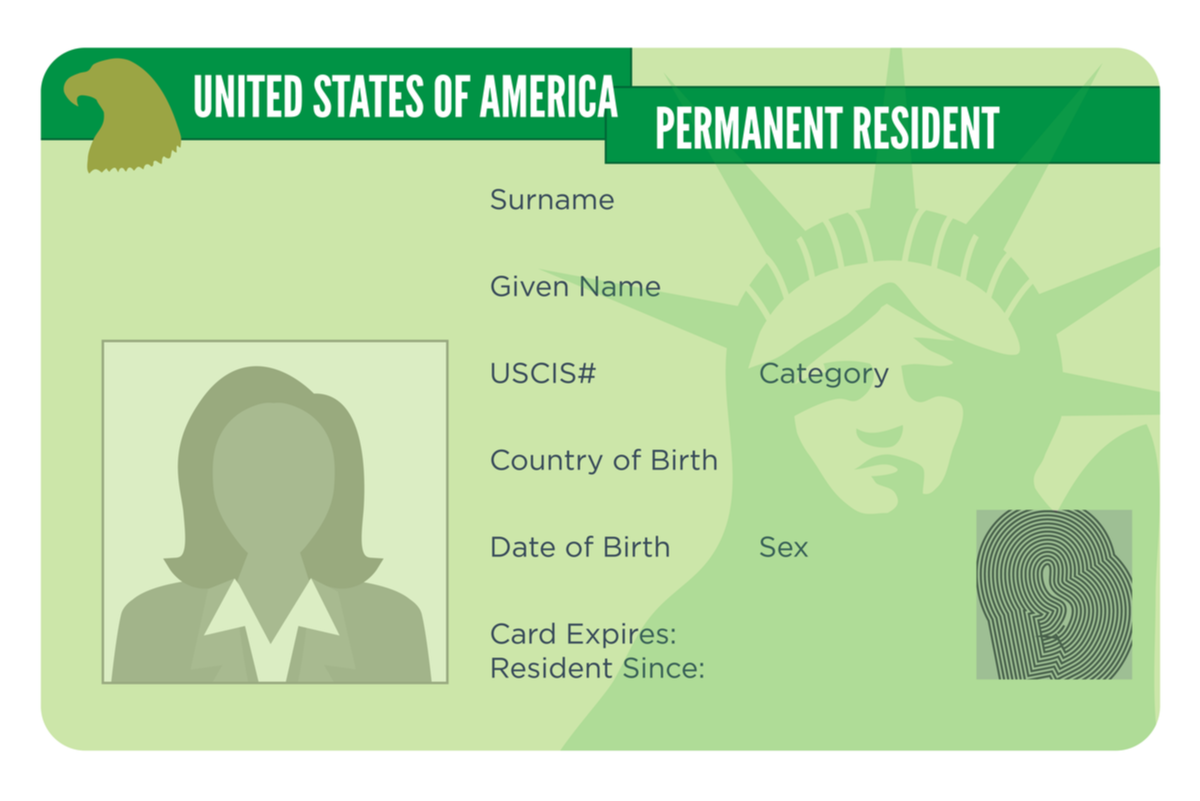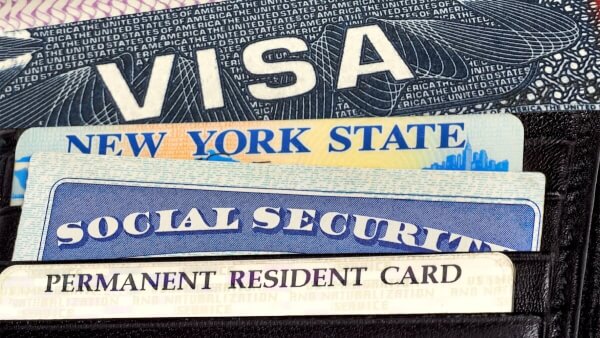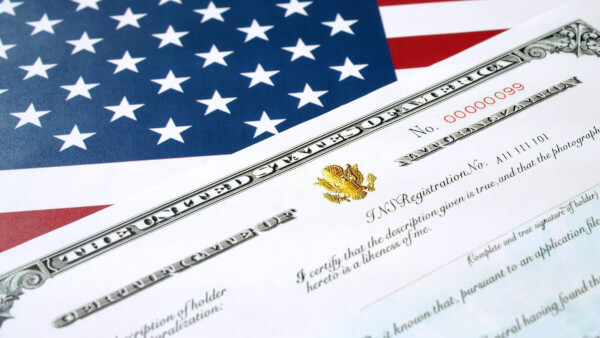Transferring your international driver's license to the US: step-by-step
Your full guide to updating your foreign driver's license to the US.

The Green Card — more properly known as a Permanent Resident Card — grants non-US citizens the right to live and work permanently in the US. It’s also a possible step on the route to naturalizing as a US citizen.
Considering applying for a Green Card? This guide walks through all you need to know, including:
| 📑Table of Contents |
|---|
Setting up your life in a new country is never cheap. To help with managing your money across borders, we’ll also introduce Wise as a smart way to send, spend and receive foreign currency payments from all over the world. More on that later.
Let’s start with the basics — what is a Green Card, and how is it different to a visa, or holding a US passport?
Most non-US citizens who wish to travel to the US will need some form of pre-approval.
For tourists headed stateside for a holiday, this may mean getting a tourist visa, or applying for an ESTA (Electronic System for Travel Authorisation)
If you’re hoping to stay permanently in the US, then applying for a Green Card may be a more attractive route. While visas are time limited, a Green Card allows for permanent US residency including the right to legally work. As a Green Card holder, you’ll remain a citizen of your home country. Although you do have expanded rights in the US compared to a visa holder, holding a Green Card does not mean you have the full benefits of US citizenship. You can’t vote in US elections for example, and can still lose your Green Card if you commit certain crimes, or leave the country, for example.
Once you’ve been granted a Green Card you may — after a fixed period of time — choose to seek US citizenship. Becoming a US citizen would mean you’re issued a US passport, and are free to leave and reenter the country at will.
| Learn more about how to naturalize as a US citizen |
|---|
The physical Green Card is a standard photo ID which contains a range of personal information and security features. Here are some key details which are included on the card:
Check out the example below:
 |
|---|
The back of the card has another photo of the card holder, a barcode and a machine readable code which is similar to that on a passport.
How to get a Green Card will vary a little depending on whether you’re applying from within the US or outside — and the exact Green Card category which you’re applying under. Here’s a broad overview of the steps you’ll need to take.
Step 1: Check your eligibility, and determine which Green Card category to apply for
Your first step will be to review the Green Card eligibility requirements by category and determine which you’ll be able to apply under. We’ll run through the different categories and their key requirements a little later. You can also find out more from the US Citizenship and Immigration Services website³.
Step 2: Apply from within the US using an adjustment of status - or from outside the US as a consular application
It’s possible to apply for a Green Card if you’re already in the US under a different visa program — or if you’re still in your home country. The application routes will be slightly different depending on your circumstances, although the key steps of filing an immigrant petition and awaiting visa availability will remain the same⁴ ⁵.
Step 3: Check visa availability
Immigrant visas for immediate family members of US citizens are not limited in numbers, but the numbers of Green Cards issued through family sponsorship and employment are capped annually. That means you may need to wait until there are visas available within your category, before your Green Card application can be processed⁶.
Step 4: Complete the necessary paperwork, and gather supporting documents
Once you’re ready to submit your application you’ll need to complete the correct application form for your category, and gather any required evidence and supporting documents. Your employer, or a family member may help you with some of this process, depending on the basis for your application. We’ll touch on the documents commonly required in just a moment.
Step 5: Attend an application support centre appointment (adjustment of status route) or National Visa Centre (consular application route)
In order to process your application you’ll have to provide biometric information including a fingerprint, photo and signature. You’ll also be asked to pay the relevant fees for your application type.
Step 6: Complete your interview if required
It’s common to be asked to attend an interview as part of your Green Card application process. You’ll receive an invitation to attend, and will have to go along with original copies of your paperwork and supporting documents. If your application is sponsored by a family member or employer they may also be asked to accompany you.
| Find out more about the Green Card interview — and how to prepare |
|---|
Step 7: Receive your application decision
If you’ve applied for your Green Card from within the US, you’ll receive a letter notifying you of the decision. If your application is denied you’ll also be given details of the reason for the decision, and your options to appeal or reopen your application.
If your application was completed using the consular route, you’ll be given a visa packet by your consular officer. You must not open this packet — instead, you’ll hand it to the customs officer upon entry to the US. The customs officer will take the final decision to approve your entry to the US, and activate your Green card status.
The exact paperwork you need will depend on your situation. There’s a full listing of immigration forms — including some 34 different Green Card documents — available on the USCIS website⁷. In most cases, you or a sponsor will need to complete an immigrant petition, such as:
You’ll then also have to complete the relevant Green Card application form based on your eligibility and application route — known as Form I-485: Application to Register Permanent Residence or Adjust Status.
The supporting documents you need to provide will vary according to your application route. There’s a handy checklist available on the USCIS website which details the documents which are commonly required⁸. Here’s a rundown:
Once your application for a Green Card has been submitted you’ll be able to review your case status online and check how it’s progressing. There are also average current and historic processing times for different application routes available online.
To give an example, here are the median processing times for Form I-485 in the six months to April 30 2021⁹:
| Learn more about how long it takes to get a Green Card |
|---|
There are fees to pay for filing many of the forms required for your Green Card application, as well as a cost for supplying biometric information for your card. There’s a handy fee calculator on the USCIS website which lets you enter your personal details and get a total cost per application form¹⁰.
To give you an idea, the cost to submit an immigration petition for an alien fiance or relative will be 535 USD. There’s then the additional cost of submitting the Form I-485, which can be 1,140 USD, plus a biometric fee of 85 USD. Don’t forget to check all of the costs for the different forms needed for your application route, over on the USCIS website¹¹.
If you make or receive payments from overseas, love to shop online with international retailers, or just like to travel, you need Wise.
| 💰 Use Wise to send money abroad using the mid-market exchange rate with no markups and no hidden fees. That can work out 6x cheaper than using your regular bank. |
|---|
You may benefit even more with the Wise multi-currency Account. Get your own local bank details for the US, Canada, UK, EUR area, Australia and more — and receive payments fee free from these major regions. Hold and switch currencies whenever you like, using the mid-market exchange rate every time. Here’s how to get started:
Green Cards are issued using a number of different eligibility categories. Here’s what you need to know.
You may be able to apply for a Green Card based on your family situation if you are:
| Want to learn more? Applying for a marriage based Green card - your step by step guide. |
|---|
If you’re in the US to work or invest, you may be able to apply for a Green Card through the employment based route. You could be eligible if you’re:
If you were granted asylum a year or more ago — or if you were admitted to the US as a refugee over a year ago — you may be able to apply for a Green Card as an Asylee or Refugee. Take a look at the USCIS website for more on the eligibility criteria and support offered.
Up to 50,000 Green Cards a year are awarded through a diversity lottery which is aimed at countries with a traditionally low rate of immigration into the US¹². To check whether you’d be eligible for this program, check out the information on the Department of State website¹³.
Individuals who arrived in the US prior to 1 January 1972 may be able to apply for permanent residence status through a process called registry¹⁴. This is available even if your stay in the US has not been lawful, provided you can comply with a range of other criteria. This route requires you to have stayed in the US continually since 1972, and be of good character.
In addition to the primary types of Green Card we have listed above, there are also some other niche application routes which may suit other situations. Full details are available online, covering Green Card options for diverse groups such as:
Getting a Green Card can be a daunting process. However, it’s an important step for many people who dream of a long term future in the US. Use this guide as a jumping off point to learn more about the eligibility routes, processes and costs, to make the journey as stress-free as possible.
And no matter whether you’re in the US already or not, don’t forget that you can save money on international payments with Wise. Send, spend and receive money from overseas, using the mid-market exchange rate with no markups - and get the Wise multi-currency Account to save 6x versus your normal bank.
Sources:
Sources checked on 06.15.2021
*Please see terms of use and product availability for your region or visit Wise fees and pricing for the most up to date pricing and fee information.
This publication is provided for general information purposes and does not constitute legal, tax or other professional advice from Wise Payments Limited or its subsidiaries and its affiliates, and it is not intended as a substitute for obtaining advice from a financial advisor or any other professional.
We make no representations, warranties or guarantees, whether expressed or implied, that the content in the publication is accurate, complete or up to date.

Your full guide to updating your foreign driver's license to the US.

Whatever your reason is for moving to the US, this guide aims to help you figure out the most important costs you'll face when you live there.

Find all you need to know about getting a personal loan for H-1B visa holders in this guide.

Everything you need to know about the US certificate of naturalization.

The US welcomes large numbers of new arrivals every year — and getting a great job to both gain experience and set down roots is a core part of the American...

Find everything you need to know about the US citizenship test, including the USCIS questions and answers.